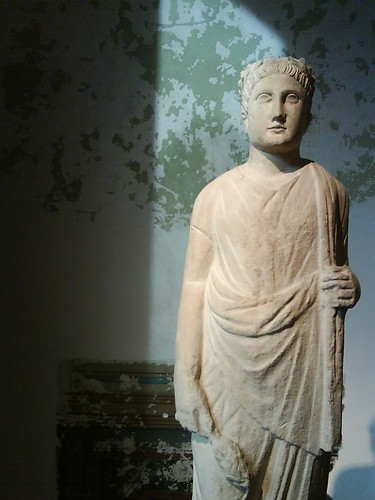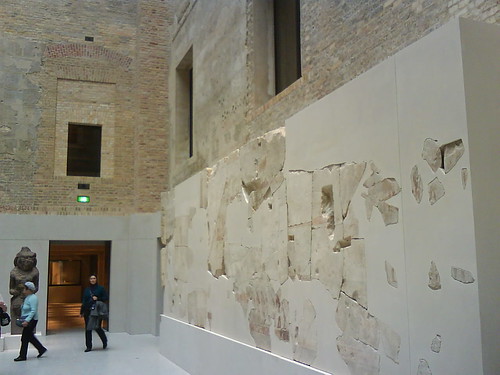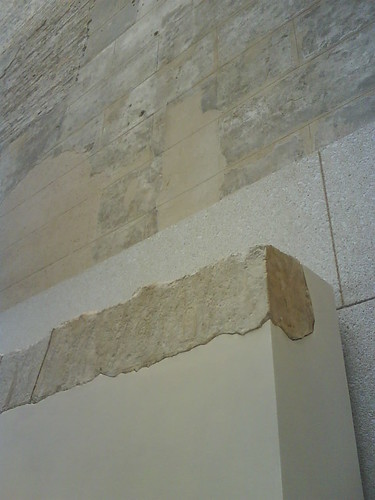The Neue Museum on Berlin's "museum island" was built between 1843 and 1855, and was one of the most notable buildings of Prussian Germany. In World War II it was bombed and pretty much destroyed.
Rather than tear it down, they left it as it was. That's not unusual in post-war Germany. For instance, the Frauenkirche in Dresden was left literally as a pile of rubble until they finally rebuilt it a few years ago. Here's the Neue Museum in 1980:
Then from 2003 to 2009, they put the Neue Museum back together again. Almost. And in October 2009, the museum opened to the public for the first time in 70 years. E. and I stood in line for a good hour to get inside on the first weekend.
The collection comprises mostly antiquities, but they are not the reason to visit. What's more interesting is the building itself, which is again complete, but which is essentially a stabilized version of its old ruined self.
The abraded walls look more like the ruins of Pompeii than a Prussian art gallery.
Many walls are rough brick. In its original state they would have been covered in plaster.
It's odd looking at fragments of antiquities in this space...
I am giving in to the undeniable fact that there is a Berlin aesthetic, and that this is it. The Berliners see their city, their space as an urban palimpsest, written upon and erased time and again. To paint the walls would be to deny history.
I'm reminded obliquely of my years in Austria. Despite having been as tangled up in the wars of the twentieth century as Germany was, Austria has a different notion of history. Like Germany, Austria was occupied by victors of WWII (and Vienna, like Berlin, was divided into sectors). It took Germany until 1989 to achieve a semblance of its former self. As such, it has a 20-year history. Austria, however, by declaring neutrality in 1955 achieved autonomy and normalcy much more handily, and as such has a 54-year history.
I wander Berlin and I see the clutter and damage of the 20th century everywhere. They're just now getting around to putting the place back together again. The Austrians were probably this far along by 1960.
One German perspective is that the Austrian history is in fact not resolved at all. The Austrians (so this line of thinking goes) think that because they were annexed they can wash their hands of their full and pliant participation in the Nazi regime. They dusted themselves off more quickly, but they've not faced the skeletons in the closet.
But the Germans, it seems to me, wallow arrogantly in their historical guilt. The reopened Neue Museum doesn't say: "We've cleaned up, and we're back to normal." Instead it says: "We have monumentalized our destruction. We will neither forget it ourselves, because we did awful things, nor let you forget it, because you did this to us."





1 comments:
Great post and photos illustrating your points. After the Waldheim Affair in the late 1980s, it was pretty difficult for Austrians to claim they were helpless victims of Hitler's aggression. They have made considerable progress in their own Vergangenheitsbewältigung in the past decade, but it's been a long time coming. (There was not even a national memorial for Jewish victims of the Holocaust until 2000.) Some say Germans had it easier, because it was harder to get away with denial in the international community. After all, the Allies encouraged Austria's facile postwar stance as "Hitler's First Victim"--thereby securing a strategic ally in Cold War tensions.
Moving even further east, the distinctions between who was a bystander, collaborator, or victim seem even blurrier. I'm curious how Hungary and Romania, for example, have dealt with their role in all this.
Post a Comment